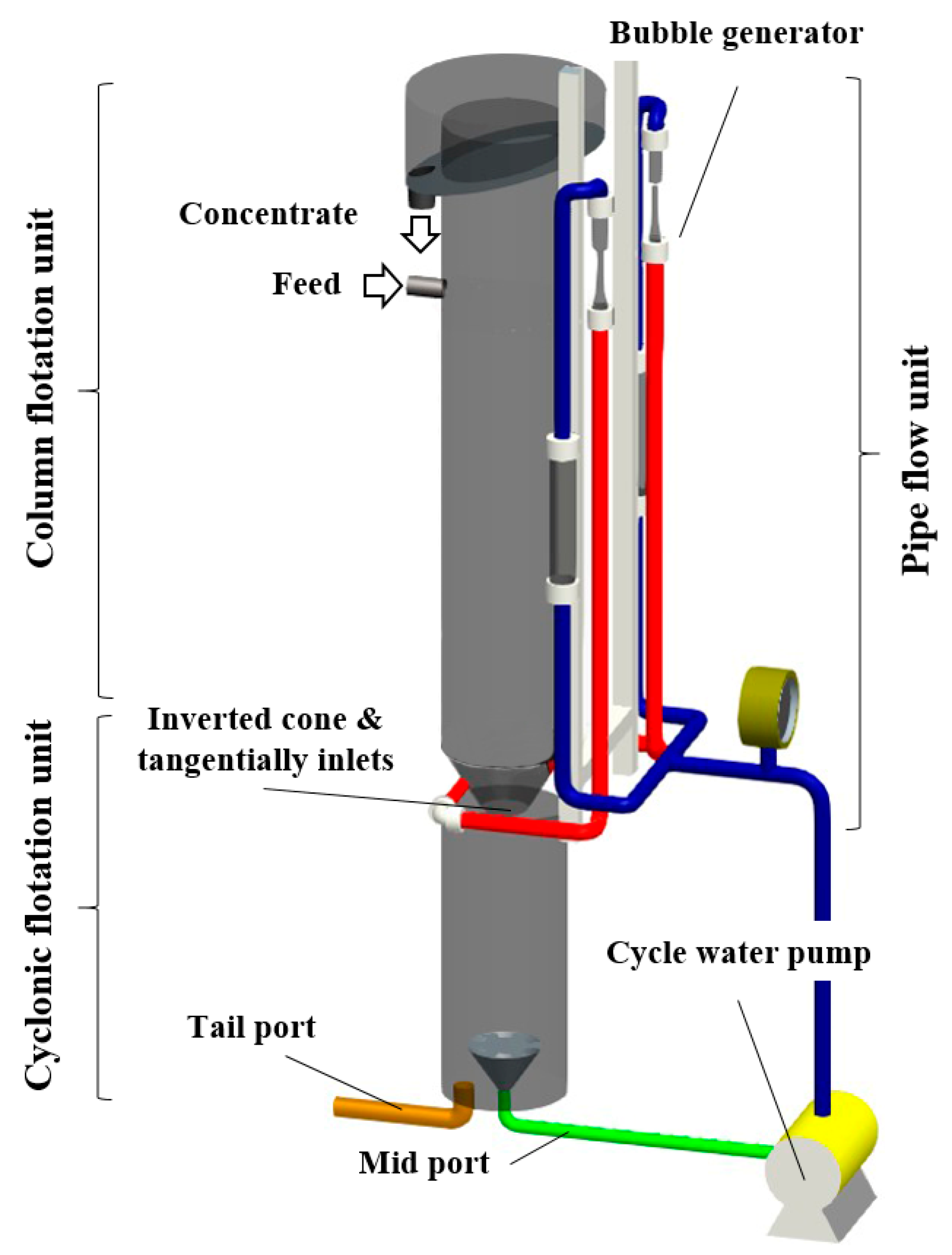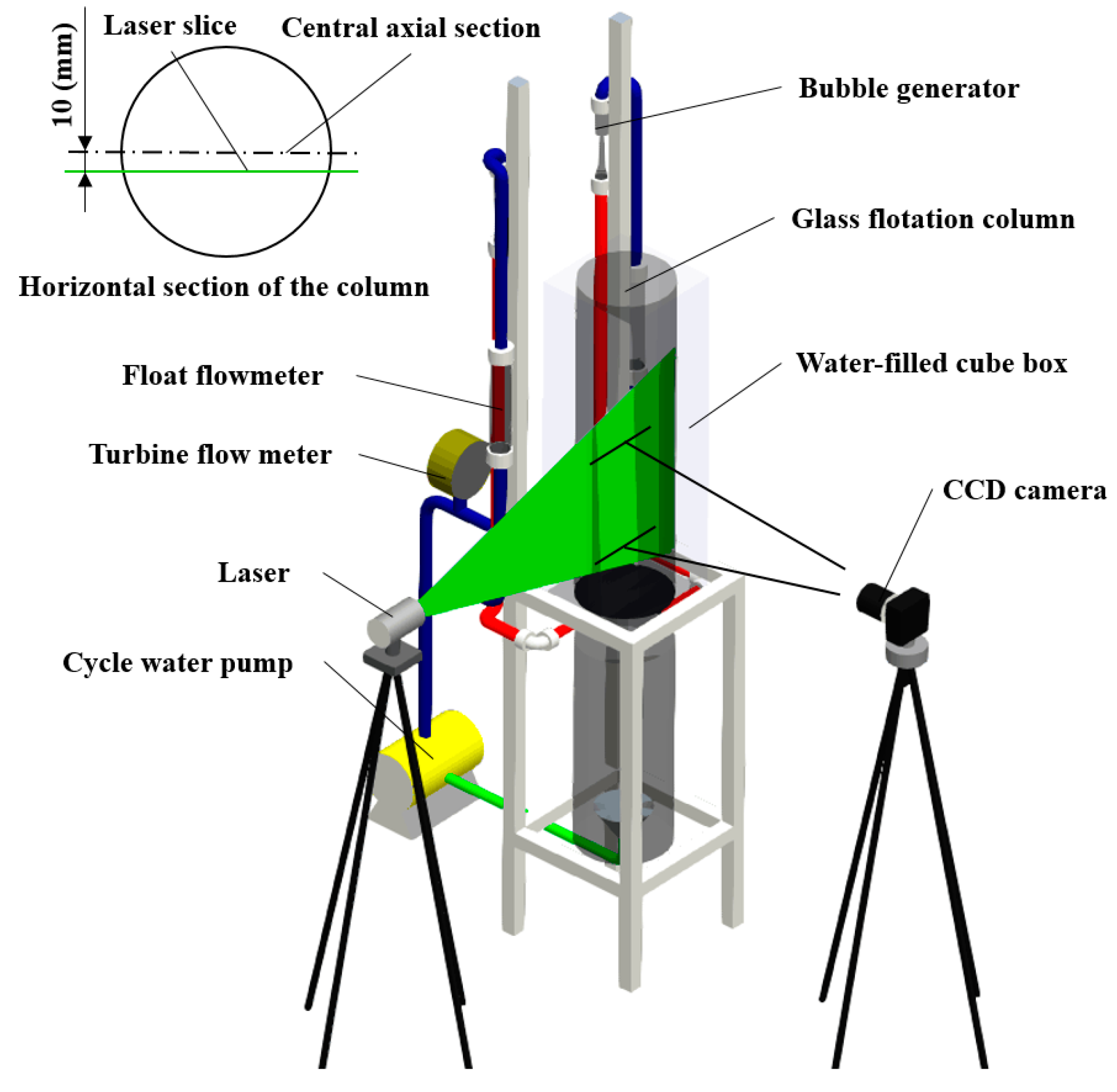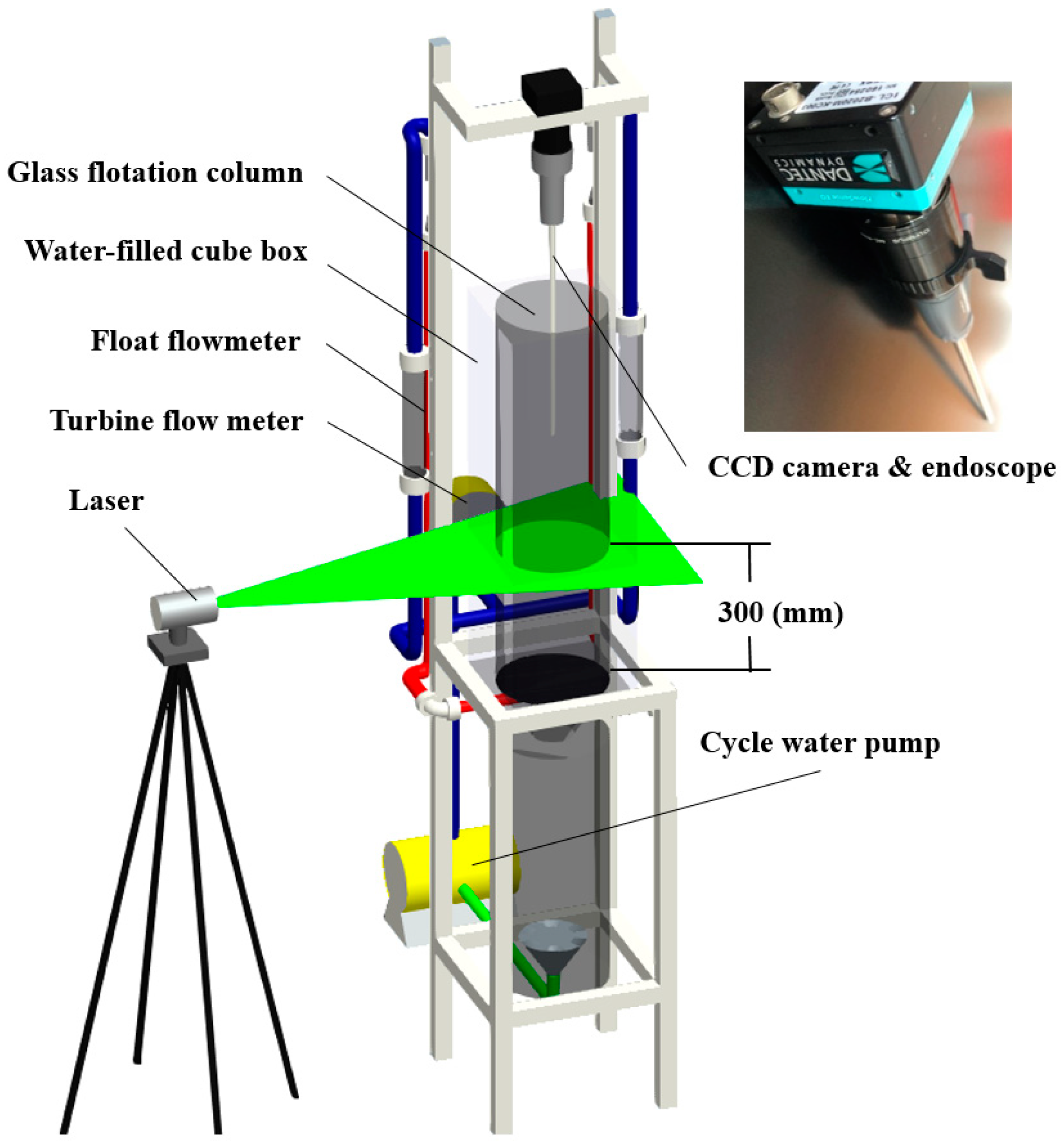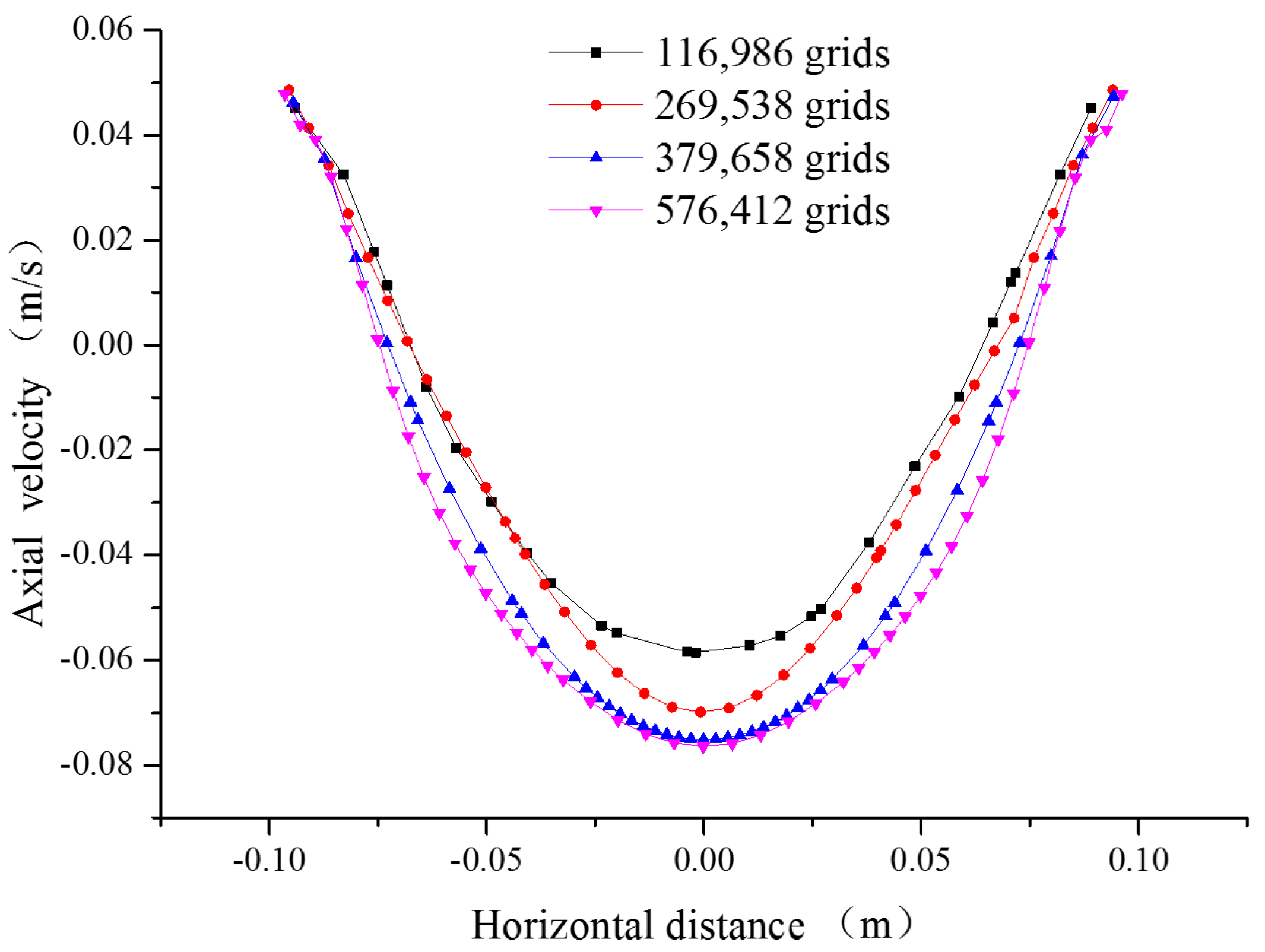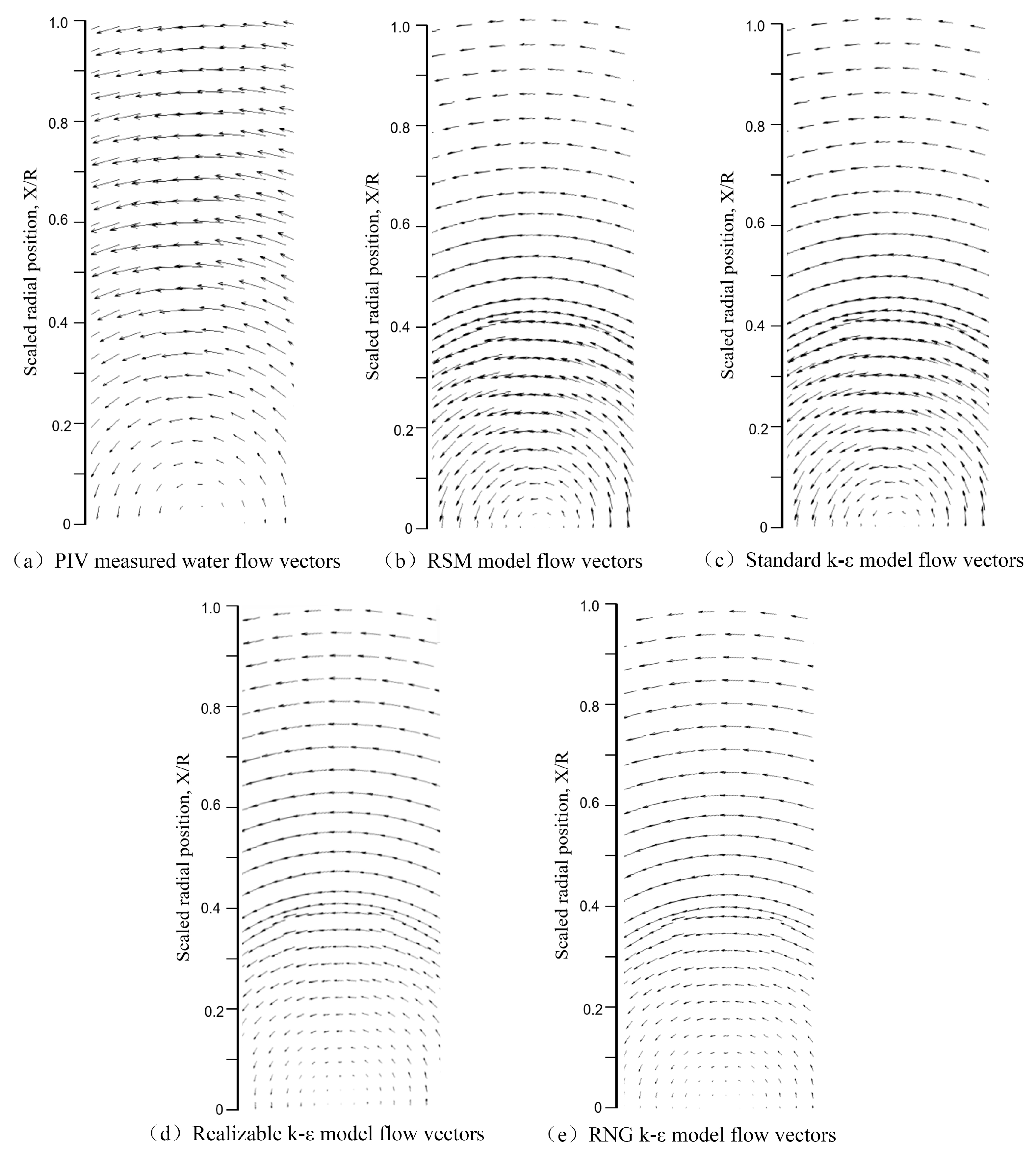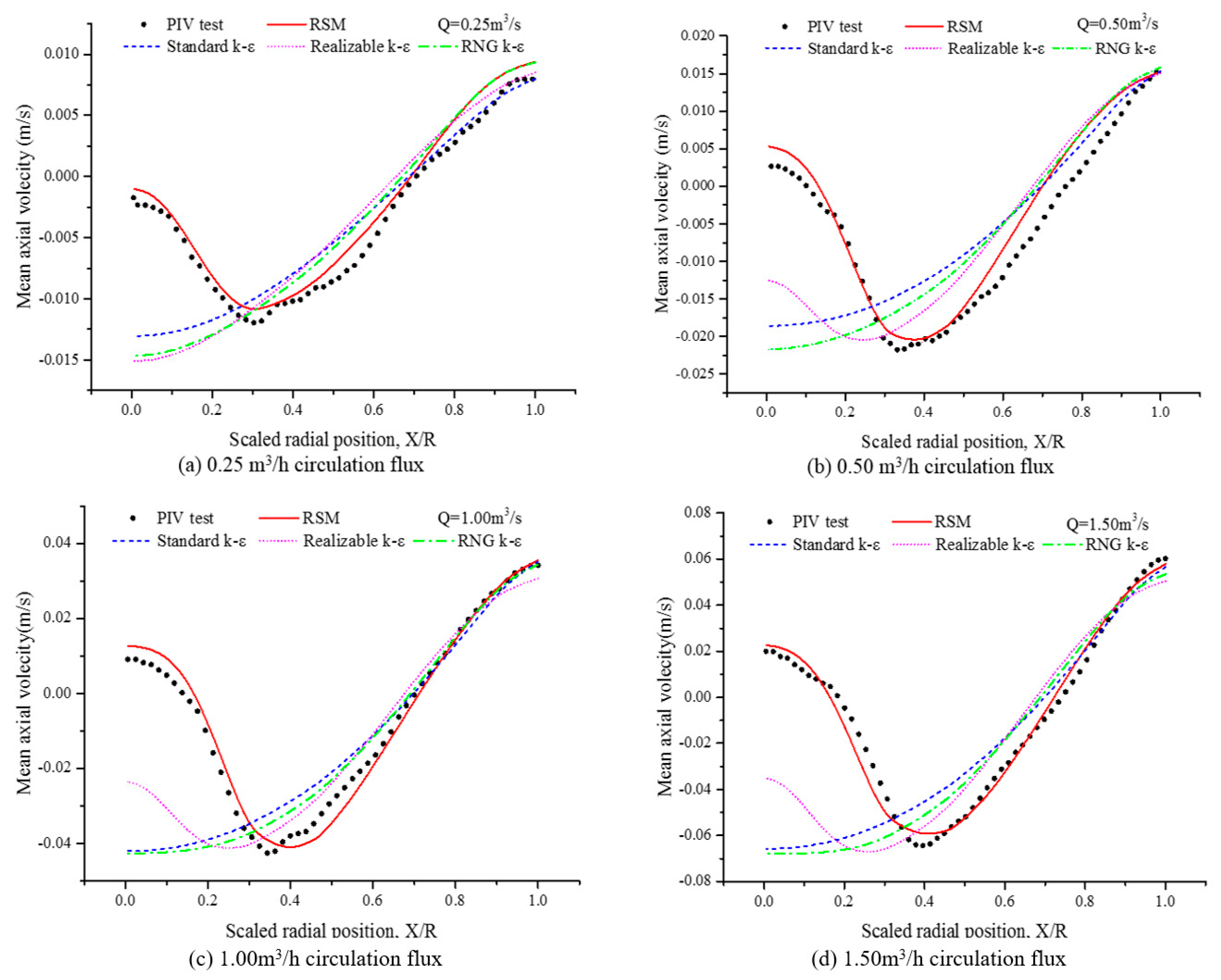1. Introduction
Cyclonic structures are employed in cyclonic static microbubble flotation columns (FCSMCs), which have sprung up since it was patented in 1999 [
1] and been successfully applied to refining stages, to facilitate centrifugal separation [
2], bubble dispersion [
3], and the reduction of sorting granularity [
4].
Figure 1 shows a typical FCSMC structure, incorporating an inverted cone in its middle part. Air is introduced and crushed into microbubbles by bubble generators in the pipe flow. The mixture of slurry and bubbles enters the flotation column from two symmetrical inlets on the swirl inverted cone, forming a swirl flow field. Hydrophobic mineral particles attach to the bubbles and are carried up to be concentrated. Under the centrifugal force in the swirling flow field, the high-density and coarse particles move outward and are discharged from the tail port. The remaining minerals enter the mid port and are separated again in the following pipe flow unit. This complex process involve lift, drag, and other interaction since gas and particles move in liquid. Under liquid forces and interface forces, collisions, adhesions, and detachments between particles and bubbles happen, as shown in
Figure 2. Generally, this process happened in a turbulence flow environment [
5] and are affected by the turbulent flow field. Therefore, the turbulence in cyclonic flow fields is an important research topic for this type of flotation column and other similar equipment.
Fine mineral particles and water are thoroughly mixed in a stirred tank to form a homogeneous slurry, and then introduced into the flotation column. Flotation feed particles are generally <0.074 mm in diameter, and flow well in the slurry. This work will provide an important reference for the study of multiphase flow in a flotation column and will have a positive impact on the industrial application of flotation columns.
Flow fields have been studied for many years with continuous developments in experimental fluid dynamics (EFD) and computational fluid dynamics (CFD). Particle image velocimetry (PIV) is an advanced EFD-based velocity measurement method developed in the late 1970s. PIV can record velocity distribution information for a large number of spatial points in the same transient state, providing flow field structure and characteristics [
6].
Although PIV has been widely used for cyclonic flow field measurement, data remains inadequate to fully reflect detailed flow features. For example, Marins et al. [
7] used PIV to measure axial and tangential velocity of a hydrocyclone without an air core to obtain the radial velocity. Cui et al. [
8] used PIV to measure axial and radial velocity in the axial section of a hydrocyclone with an air core, but cross-section measurement was not possible due to overflow. Tangential velocity is particularly difficult to measure for flotation columns since the column top is open and the swirling flow interferes with the light path. Yan et al. [
9] and Wang et al. [
10] used PIV to measure single-phase cyclonic flow fields for flotation columns, but only obtained axial velocity by measuring one quasi axial section of the flotation column under a fixed volume flow rate.
Computational fluid dynamics provides effective methods to numerically study flow fields and has been successfully used to calculate various cyclonic equipment parameters. However, numerical simulations tend to simplify boundary conditions and material properties, and discretization differences can lead to different results. Therefore, numerical simulation requires experimental data to verify its reliability. Reasonable numerical simulation has a guiding effect on experimental and theoretical analysis, which can make up for the lack of experimental work. The turbulence model selection has significant influence on CFD simulation accuracy for single-phase cyclonic flow. Due to the large resources occupied by DNS (direct numerical simulation) and LES (large eddy simulation), the Reynolds stress model (RSM) and
k-ε turbulence models are more commonly used for column simulation. Khan et al. [
11] proposed a three-dimensional (3D) model of a bubble column simulated using
k-ε and RSM models. They performed LDA (laser doppler anemometry measurements) in the column to verify the simulation, and confirmed that
k-ε and RSM models could effectively predict bubble column internal flow fields. However, several issues remain for application of these turbulence models to cyclonic flow simulations. Wang et al. [
10] compared single-phase PIV experiment results with CFD predictions, and concluded that the RSM model was more suitable for single-phase cyclonic field simulation in a FCSMC. Zhang et al. [
12] and Yan et al. [
13] used the standard
k-ε turbulence model to simulate single-phase internal flow fields within flotation columns and analyze their benefits. Swain et al. [
14] used RSM and standard
k-ε models to simulate gas–liquid two-phase flow in a hydrocyclone, and concluded that both models could predict the hydrocyclone flow pattern. Azadi et al. [
15] used RNG
k-ε and Reynolds stress models to calculate cyclonic flow fields, and showed that RSM predictions produced smaller deviations but required higher computational power than the RNG
k-ε model.
Two main problems have prevented flow field application to cyclonic flotation columns: Measured data is not available for the tangential section and turbulent numerical models remain uncertain.
Therefore, the current study first improved the traditional PIV experimental method for flotation columns, and then developed an experimental platform for measuring the swirling field axial and cross sections inside a flotation column, providing detailed flow field information including axial, radial and tangential velocity. We subsequently performed 3D and unsteady single-phase simulations for cyclonic flotation columns, and investigated different turbulence model suitability to accurately model single-phase flow fields inside the flotation column. This study provides a new reference for numerical studies and PIV tests on flotation columns and similar equipment flow fields.
4. Conclusions
We performed numerical simulations and PIV measurements for a single-phase swirling field in a lab-scale FCSMC at four circulation fluxes (0.25, 0.50, 1.00, and 1.50 m3/h). Axial and radial velocity distributions were measured and modelled on the flotation column quasi-axial section. Experimental errors due to refraction at the free surface were avoided by adding an endoscopic lens to the CCD camera, inserting the speculum below the free surface, and allowing tangential velocity distribution to be measured on the indicated section. The RSM, standard k-ε model, realizable k-ε model, and RNG k-ε model were used for CFD simulations for FCSMC single-phase swirling fields. Comparing the PIV experimental and simulation results and of the PIV, we made the following conclusions:
(1) Standard k-ε model and RNG k-ε model. Radial and tangential velocity distribution trends simulated by these models were consistent with PIV measurements, but axial velocity along the horizontal direction deviated widely from PIV results. Thus, axial errors were not considered. Mean absolute radial and tangential velocity deviations were 37.25% and 38.92%, for the standard k-ε model and slightly better for the RNG k-ε model (32.82% and 29.60%), respectively.
(2) RSM and realizable k-ε model. Radial, tangential, and axial velocity distribution trends simulated by these models were all consistent with PIV measurements. Mean absolute axial, radial, and tangential velocity deviations were 17.36%, 14.79%, and 13.48% for the RSM model, and 78.11%, 28.94%, and 26.12% for the realizable k-ε model, respectively. Therefore, the RSM model exhibited superior performance, particularly in the axial direction.
(3) The
k-ε models [
26] are based on isotropic assumptions with semi-empirical formulas summarized from experimental results. However, the internal flow field of the flotation column is a high-intensity vortex field with a large turbulent velocity gradient and fluctuating turbulent velocity, and hence is not approximately isotropic. The RSM model [
27] abandons the isotropic assumption, considering laminar flow and Reynolds stress, and hence is suitable for anisotropic cases, especially the swirling flow field inside the flotation column. In fact, the RANS (Reynolds Averaged Navier-Stokes) model [
28] does not distinguish between the size and direction of the vortex, and it is limited by the model conditions. Thus, it is difficult to get perfect results for complex problems such as an inverse pressure gradient numerical simulation. In addition, the RANS model relies on boundary conditions, so the calculations are very computationally dependent. DNS and even LES are good choices without considering computational costs and widespread adoption.
